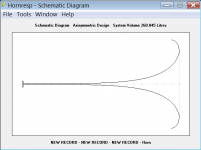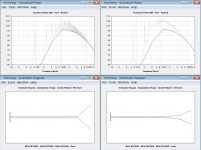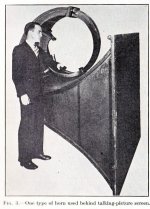Good day.
I was wondering if it was possible to use a super long horn adapter (lets say 1 to 2 meters long) so as to create a delay. Kind of like a horn instrument (french horn) where the diameter of the horn is basically the same for most of its length until the end. How would this affect the response, this extra 1 or 2 meters. The idea would be to use a compression driver that goes from 1k to 15khz.
Thanks,
I was wondering if it was possible to use a super long horn adapter (lets say 1 to 2 meters long) so as to create a delay. Kind of like a horn instrument (french horn) where the diameter of the horn is basically the same for most of its length until the end. How would this affect the response, this extra 1 or 2 meters. The idea would be to use a compression driver that goes from 1k to 15khz.
Thanks,
I suspect it could be done but I'd want to be careful about resonance within or along the adapter.
Do a sim using a spiral staircase like shape.
Otherwise supporting it will cause problems.
And think of using it above 5 kHz, and a mid or full range driver for the frequencies below that.
Otherwise supporting it will cause problems.
And think of using it above 5 kHz, and a mid or full range driver for the frequencies below that.
A long adapter could be used for time delay, but it will create a series of peaks and dips in the response, commonly called “comb filtering”.I was wondering if it was possible to use a super long horn adapter (lets say 1 to 2 meters long) so as to create a delay.
Here is a Hornresp simulation of a compression driver on a conical horn, then the same with 1 and 2 meter extensions:

In a horn instrument, the peaks and dips are part of it’s sound and harmonic structure.
In a reproduction system, the comb filtering tends to sound like a phasing or flanging effect, artificial and hollow.
Easy to hear the effect- listen to someone talking through a pipe or a hose.
That said, the 1971 vintage Cooper Time Cube effect used Shure microphone capsules on each end of hoses used as transducer and microphone for a 14ms, 16ms, or a combined 30ms delay. No tape to wear out, and was less expensive than digital delay back then. OK as an effect added to a studio mix, not so great for delay.
Now a full bandwidth, flat response digital delay chip with 120dB S/N probably costs less than the hose the Cooper Time Cube used!
Art
You will get a Kundt's Tube effect, better go for an electrical / electronic solution, mechanical will cause terrible distortion in audio use.
https://www.google.com/url?sa=t&rct...ndt%27s_tube&usg=AOvVaw1wooRUDdFqTGvp0KfHH1jv
https://www.google.com/url?sa=t&rct...ndt%27s_tube&usg=AOvVaw1wooRUDdFqTGvp0KfHH1jv
I see what you did there. Can the number of resonant modes be related to the "termination impedance" at the far end? Whereby you made a better match with the two part flare? Is there a shape then that would minimize them all, if one kept iterating out to n-part flare?on what you put at the end of it
Or is there only so much you flare can do?
Actually thought "what if the long pipe part gradually increased in diameter along its length, until it flared at the end", but kept my mouth shut as it was an unexperienced guess at best.
That is indeed a good idea. The only downside is that it limits the choices of horn you can use.
If there is no energy reflected back down the pipe (and no HOMs) then you have no problem. No shape is perfect but it's interesting to look at the tractrix/LeCleach varieties. They tend to let go of their issues along the way down the horn, kind of a distributed diffraction thing which is why they are so popular as terminations. Some people shy away when they hear the words distributed diffraction but lets face it, something has to give here, it's just a matter of what.
It's a shame hornresp won't combine the two shapes in an easy to sim way, but you can use it to study the LeCleach on its own.
If there is no energy reflected back down the pipe (and no HOMs) then you have no problem. No shape is perfect but it's interesting to look at the tractrix/LeCleach varieties. They tend to let go of their issues along the way down the horn, kind of a distributed diffraction thing which is why they are so popular as terminations. Some people shy away when they hear the words distributed diffraction but lets face it, something has to give here, it's just a matter of what.
It's a shame hornresp won't combine the two shapes in an easy to sim way, but you can use it to study the LeCleach on its own.
Last edited:
Use DSP, it's way less work.
A diffraction slot that's even half an inch long will significantly impact the frequency response and impedance of your speaker, and I couldn't even imagine using a slot that's longer than four inches long.
Basically, I agree with Art.
A diffraction slot that's even half an inch long will significantly impact the frequency response and impedance of your speaker, and I couldn't even imagine using a slot that's longer than four inches long.
Basically, I agree with Art.
Specify the long adaptor using Ap1 and Lp rather than segment 1.It's a shame hornresp won't combine the two shapes in an easy to sim way, but you can use it to study the LeCleach on its own.
Whatever the chosen termination though, the performance is unlikely to be particularly satisfactory 🙂.
Attachments
BLUF: it's possible but non-trivial, requires driver modification, BEM simulation and 3D-printed parts.
If - that's a big enough "if" - your driver emits a perfectly planar wavefront, you can sent this wavefront down any length of pipe and it will travel unperturbed - i.e. the wavefront will enter the horn like the pipe isn't even there. Most drivers have non-zero exit angle, so at minimum you need a throat insert to extend a straight tube right down to the phase plug exit. To avoid reflection you need to have a gradual transition from the pipe to the waveguide, not unlike the throat section of the oblate spheroid waveguide, or, even better, a wavefront transformer like this: https://at-horns.eu/release/Ath-AP1.pdf
If you are serious about designing unconventional horns/WGs, please take a look at the ATH thread. ATH is the most powerful tool for horn design now. The learning curve may be a bit steep, but it's woth it.
https://www.diyaudio.com/community/threads/acoustic-horn-design-the-easy-way-ath4.338806/
If - that's a big enough "if" - your driver emits a perfectly planar wavefront, you can sent this wavefront down any length of pipe and it will travel unperturbed - i.e. the wavefront will enter the horn like the pipe isn't even there. Most drivers have non-zero exit angle, so at minimum you need a throat insert to extend a straight tube right down to the phase plug exit. To avoid reflection you need to have a gradual transition from the pipe to the waveguide, not unlike the throat section of the oblate spheroid waveguide, or, even better, a wavefront transformer like this: https://at-horns.eu/release/Ath-AP1.pdf
If you are serious about designing unconventional horns/WGs, please take a look at the ATH thread. ATH is the most powerful tool for horn design now. The learning curve may be a bit steep, but it's woth it.
https://www.diyaudio.com/community/threads/acoustic-horn-design-the-easy-way-ath4.338806/
Thanks David. I'm happy to be set straight on this, as I continue my long tradition of using this fine software.
I decided to use your suggestion to press the point, and it seems there is a point when increasing the terminating horn that it will overshadow the adapter and give a better result using the adapter, than the original smaller horn without the adapter. Unfortunately the design priorities had to be focussed toward the termination in this case.

I decided to use your suggestion to press the point, and it seems there is a point when increasing the terminating horn that it will overshadow the adapter and give a better result using the adapter, than the original smaller horn without the adapter. Unfortunately the design priorities had to be focussed toward the termination in this case.

Wow! What great responses. Thanks for taking the time to do the sims weltersys and AllenB. I can see how playing with Hornresp can direct you to a better design. I will start using this software. THanks VoxCelestial for the reference to the wavefront transformer. I am playing around with 3d printers so this would be super interesting when using the ATH software. My idea was to use the delayed uncorrelated sound to create better envelopment and a better soundstage when matched to a main constant directivity speaker system in a passive way (so no digital delay). Much like what Audiokinesis does with its LCS (Late Ceiling Splash) but instead increasing the delay with compact tubing which could be located in the main loudspeakers.
Just keep in mind that depending upon the power levels involved, distortion may become a problem due to the presence of the non-flaring long adaptor, and that there will always be a degree of acoustical impedance mismatch at the interface between the adaptor and the horn proper, no matter what horn / waveguide profile is used.I can see how playing with Hornresp can direct you to a better design.
This is why you won't see many loudspeaker systems using such a design 🙂.
I once tried to simulate an E flat tuba in Hornresp. Kinda worked. Maybe I still have the file. That’s a long tube with a flare at the end.
This is what a speaker will sound like through a long guide...
Image off the net, no ties to seller...

Image off the net, no ties to seller...
The Bessel profile would probably be the best one to use for such a simulation.I once tried to simulate an E flat tuba in Hornresp.
Attachments
Wow! What great responses. Thanks for taking the time to do the sims weltersys and AllenB. I can see how playing with Hornresp can direct you to a better design. I will start using this software. THanks VoxCelestial for the reference to the wavefront transformer. I am playing around with 3d printers so this would be super interesting when using the ATH software. My idea was to use the delayed uncorrelated sound to create better envelopment and a better soundstage when matched to a main constant directivity speaker system in a passive way (so no digital delay). Much like what Audiokinesis does with its LCS (Late Ceiling Splash) but instead increasing the delay with compact tubing which could be located in the main loudspeakers.
This just sounds like a really bad idea.
You're adding a second source that doesn't match the frequency response of the first source.
I don't understand why you don't just use DSP.
After reading this I remember adding a 2 meter long tube to a portable boat horn. This was over 30 years ago.
I cut the horn and inserted about 2 meters of pvc tube between the "driver" and the horn.

Big fail. It didn't work at all, no honk. Almost no noise. That's when I realized that the horn and driver are tuned for that big "Blat!!" of sound. Detune it and the honk doesn't happen.
I cut the horn and inserted about 2 meters of pvc tube between the "driver" and the horn.
Big fail. It didn't work at all, no honk. Almost no noise. That's when I realized that the horn and driver are tuned for that big "Blat!!" of sound. Detune it and the honk doesn't happen.
- Home
- Loudspeakers
- Multi-Way
- Super long adapter for Horn so as to create time delay?



